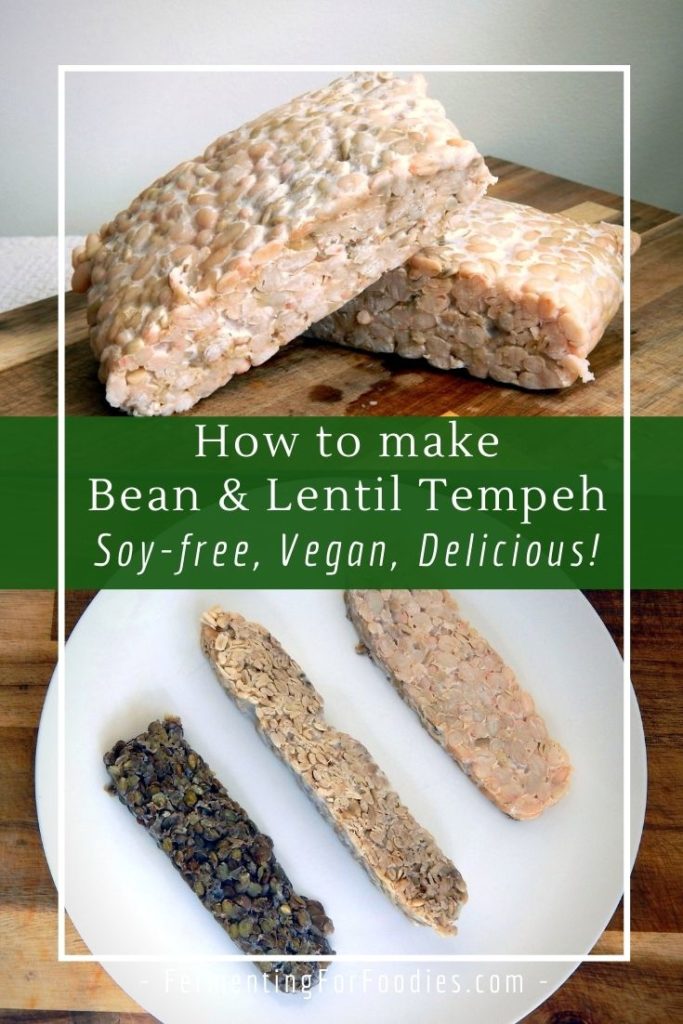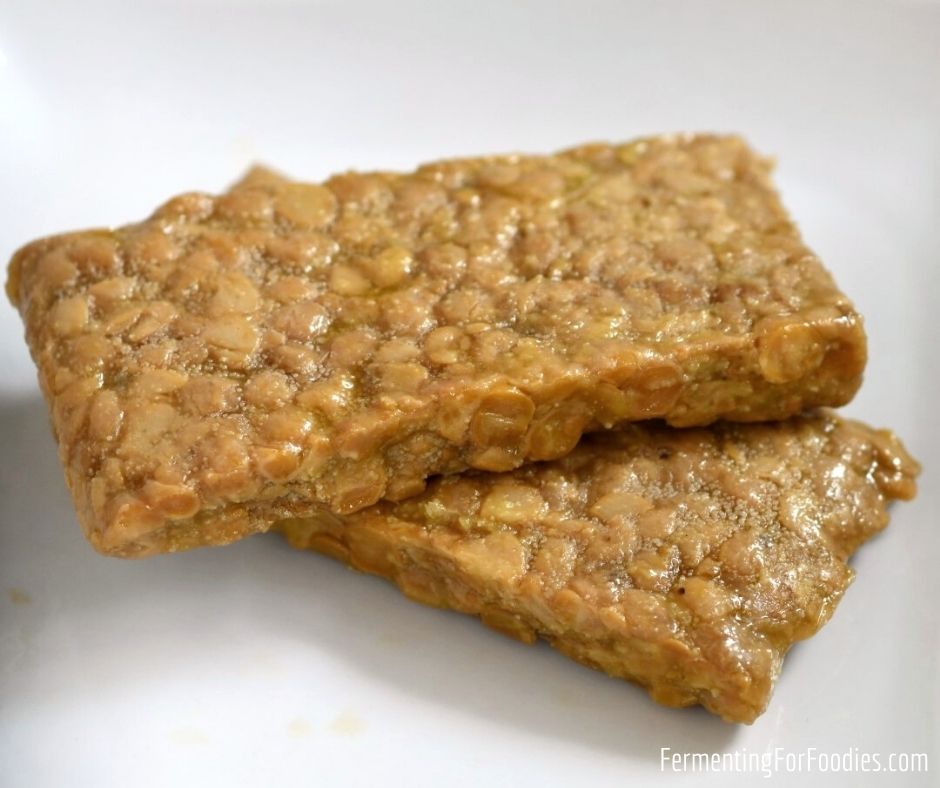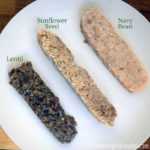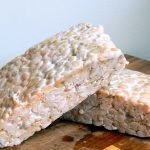
Did you know that tempeh can be made from any type of lentil or bean? In fact, these other types of tempeh are so much easier to make than soybean tempeh, because they don’t involve the work of cracking and dehulling the soybeans. So, lentil or bean tempeh is perfect for beginners.
Making lentil and bean tempeh
I have already written a few posts on tempeh, so for this post, I am going to focus on how to specifically make lentil, chickpea, or bean tempeh. For information on the type of container to ferment in, and how to maintain the incubation temperature read my posts on sunflower seed tempeh or soybean tempeh.
Lentil Tempeh
Lentils tempeh isn’t as firm as other forms of tempeh. It has an earthy and rich flavor, so I usually serve lentil tempeh crumbled in tacos, on pasta, or as a layer in a lasagna. (It’s the dark grey/brown patty in the picture above).
How to prepare lentils for tempeh:
- Use whole lentils, not split lentils which tend to disappear when cooked.
- Boil lentils until just tender (about 15 minutes for brown, green or French lentils). The lentils need to hold their shape to create a nice firm tempeh.
- Lentils tend to hold onto a lot of extra moisture, so be sure to drain well, and continue stirring them while they cool so the excess moisture will evaporate.
Chickpea Tempeh
Chickpea tempeh is very similar to soybean tempeh. It has a similar color, shape, and texture. The only trick to making chickpea tempeh is that you need to use small chickpeas, or it will be too difficult for the tempeh mold to penetrate the beans.
How to prepare chickpeas for tempeh:
- Buy the smallest chickpeas you can find (aim for the size of a soybean). Or sort through your chickpeas for the smallest ones.
- Soak the chickpeas for 6 to 8 hours.
- Boil the chickpeas until soft, but not mushy (about 30-40 minutes depending on the size of your chickpeas).

Bean Tempeh
Bean tempeh is a lot of fun. Here’s where you get to be creative! Black beans will make dark grey tempeh. Navy or white beans make tan-colored tempeh. I like mixing my bean tempeh with a 1/4 cup of sunflower seeds or sesame seeds. The mix of seeds and beans gives the tempeh a delicious flavor and to turns it into a complete protein. The only trick to making bean tempeh is to avoid using beans that are too large or have thick skin as these will not culture very well. (See navy bean tempeh in the picture at the top of the post).
- Use small beans like black beans, black-eyed peas or mung beans. Large beans like kidney beans or great northern white beans won’t culture very well. Lima beans and broad beans have a thick skin which won’t allow the tempeh mold to grow.
- Soak the beans for 6 to 8 hours.
- Boil the beans until soft, but not mushy (about 50-75 minutes). If you are going to use sunflower seeds, boil them with the beans.
Lentils, Chickpeas and Bean Tempeh
Did you know that tempeh doesn’t always have to be made with soybeans? Tempeh can be made from all different types of beans and lentils. And bean tempeh is so much EASIER to make than soybean tempeh.
- Prep Time: 10 minutes
- Cook Time: 30 minutes
- Total Time: 40 minutes
- Yield: 2 cups 1x
- Category: Main Dish
- Method: Fermented
- Cuisine: Vegan
- Diet: Gluten Free
Ingredients
- 2 cups of dried beans or lentils
- 2 tbsp white vinegar
- 1 tsp tempeh starter
Instructions
- Prepare the beans or lentils as described in the section above. They need to be cooked until soft, but not mushy.
- After cooking the lentils/beans, drain them, and allow them to cool to just above room temperature. Toss 3-4 times during the cooling process so that they dry as they cool.
- Mix in the vinegar, then sprinkle on your tempeh starter and mix well.
- Fill your fermentation container. See this post for details on what type of container to use.
- Incubate at approximately 88 F (31 C). I use this folding fermentation box (affiliate link).
- Check after 12 hours. At this point the mold will have started to grow and the tempeh will begin to generate its own heat. Depending on what you are using for incubation, you may need to lower the temperature. (The fermentation box will automatically keep it at the right temperature, but if you’re using a dehydrator or heat pad, you will need to adjust).
- The tempeh will be done sometime between 24 and 48 hours. It’s done when the mold has thickened the lentils/beans into a single dense patty. There might be some grey or black mold spores, but you want to stop incubation before there’s too a lot of spores.
- Store the tempeh in the fridge to curb fermentation. Either eat it raw within 3 days or steam it to completely halt the fermentation. (See notes for details).
Notes
- You can find tempeh spores online
(affiliate link). If you plan on making lots of tempeh I recommend making your own tempeh starter.
- Black and gray spots may appear on the tempeh. These are the mold spores, and they are completely edible. Delicious tempeh should smell nutty and mushroomy. It might have a hint of ammonia, but it should never smell bad.
- To completely hault the fermentation, steam tempeh for 20 minutes. Steamed tempeh will last for 1 week in the fridge or 3 months in the freezer.
- The vinegar is necessary because it lowers the pH of the beans to the ideal level for tempeh mold.




I became so excited when I read that tempeh can be made from other beans, lentils, and seeds! I love tempeh, and all I get is store bought. I grew up on a hippy commune in Tennessee where several soy products including fresh tempeh was made. It just occurred to me that maybe I could make some myself at home. And next I wondered if other kinds of beans could be used in place of soy. And here you are with all this lovely info! Thank you 🙂
Thanks!
I’m trying to make tempeh myself but I’m having a devil of a time with temperature control. I’m using split mung beans. They grow three times in size after soaking overnight then I steam them for 10 minutes in my Instant Pot Ultra. After cooling I add rice wine vinegar, sesame seeds, and tempeh starter. I pack that in a quart size Ziploc bag and use the Instant Pot’s Yogurt function on low which is set to a temp of 91 degrees. After 12 hours the temperature of the Tempeh is starting to climb to 94 degrees. I thought I could just move the glass lid a bit to allow some heat to escape but when I checked the temperature six hours later it was at 107 degrees so I discarded that batch and will try again.
You don’t need to discard it if it gets too hot. Just pull off the lid, or use a tea towel instead. The extra heat is coming from the tempeh mold, so it’s still alive!
I put my chickpea tempeh i was incubating in the Instapot, in oven for the last 4-5 hours on warm, so I could use my Instapot for making soup tonight. I didn’t know our oven warm setting min temperature was 170F. This was already after the first 48hr incubation period. Last I checked the tempeh got as warm as 135F. Is it still ok to continue to ferment the chickpeas? I was going to leave it in the oven over night, with it off, to continue fermentation, but now I wonder if I need to out it in the fridge. It smells really good. I hope I didn’t just cook it in a ziploc bag.
It sounds like it had already started a good ferment with the 48 hours of incubation. However, it only takes 40 minutes at 135 F to pasteurize your culture. I think you should stick it in your fridge and enjoy it. It sounds like it’s ready to eat. 🙂
My next batch was a success. I prepared it but wanted to let it run overnight so I put the bagged tempeh in the bottom part of the fridge for about 8 hours till I was ready to start. I wanted to monitor the temps carefully so I used a digital thermometer with an external probe and put the probe in the center of the Ziploc bag. Temps started at 44.1 degrees F but after 16 hours in my Instant Pot Ultra on low Yogurt setting the tempeh was maintaining 92.1 with the lid off. I moved it to a tea towel sitting in a quarter sheet pan. The temps topped at 99.7 but at 24 hours still wasn’t seeing any visible mold growth, At 32 hours I was noticing some changes as the temp was slowly decreasing. Now at 42 hours I have really solid coverage and the temp is back to 92.1 degrees.
I do love that warm mushroom smell.
Great! Fresh tempeh is SOOO delicious!
I found my favorite container for making tempeh. I pulled a Glad 3 1/8 cup container from my cabinet. I used an awl and some high density foam for support and carefully poked holes every 1/2 inch all around the container and its lid. I used a drill with an expanding bit to make a hole in the lid for the temperature probe. One of my local stores has a 10 bean soup mix in their bulk bin that makes some good soup so I soaked a cup of it in water for 12 hours. It expanded to over the 3 cup mark. I drained and rinsed it then steamed it for 20 minutes. This broke down all the lentils but left the red, black, and black eye peas intact. The prepared mix filled the container completely. Temps went to 120 degrees F but 40 hours later I had a 13 ounce loaf of tempeh.
Great!
Hello! I have been making my mung bean tempeh for a while now. I am transitioning to a plant-based keto diet and I understand that regular soy tempeh is keto friendly. Any thoughts on tempeh made from other beans/ legumes? I hear that it is the process of fermentation which somehow digests the carbs….
How about sunflower seed tempeh: https://www.fermentingforfoodies.com/archives/4957
It’s my favourite! Very nutty.
I made soybean tempeh successfully. I just tried making chickpea tempeh but only a bit of white mold formed and the rest of the beans turned gray/brown. It tastes funky. Should I try splitting the chickpeas in a blender before boiling them to create smaller more compact tempeh so that the mold spreads throughout?
It’s important to use small chickpeas because large ones don’t culture quickly enough. I sort to get a batch of really small chickpeas for tempeh. Cracking them is a great idea! Split chickpeas should culture quickly.
Awesome recipe! Thank you for sharing this, I’ve looked online for this specific topic before and just so happened to come across your great content on Pinterest!
This traditional preparation method will be a great way to start using more of my dried legumes up, for sure. There’ll be many nutritional benefits in using this for new recipes.
Honestly, I’ve never tried to make tempeh before, but love to experiment and now I can’t wait to give this a go. Once, I did try to ferment cooked mixed beans using a little water from sourdough oats as a basic starter, and they were coming along quite well… Then I left my mason jar on holiday – oops!
Keep up the great ideas, best of wishes,
James
Thanks!
Hi Emillie. This is my first time making tempeh. Do lentils tempeh take quite sometime to be fully done? I’m currently fermenting lentils tempeh and it has been 4 days but the mold has not fully formed and they are not firm. Should I just discard this batch?
Lentil is the one type of tempeh that doesn’t become completely firm, so I usually use it with pasta or other dishes where I want a crumbled protein. I think it’s in part because lentils are quite soft and crumbly themselves. After 4 days it should probably be finished. Enjoy!
Thanks for this great info! I recently tried making chickpea tempeh based on a different recipe. That recipe emphasized de-hulling the chickpeas after cooking them. I did this by hand and it took forever / was very painstaking. I notice you don’t say anything about de-hulling here. Can you clarify whether this is part of your process?
Can you also clarify what you mean when you say look for small chickpeas? In my experience chickpeas only come in one size and are quite small when dry regardless.
Thanks and blessings,
J.
Nope… however, you either need to use really small chickpeas (which is what I do) or crack the chickpeas so they are halved. I recommend just sorting your bag of chickpeas for the smaller ones. Alternatively, just use another bean. I like navy beans best.
Hi Emillie,
I’m waiting for my first batch of black been tempeh to develop. It’s been three days so far and finally I can see spores forming. I have the tempeh in quart size ziplock bags with holes every inch around. I used apple cider vinegar instead of white or rice vinegar. What’s the difference between using white vs. apple cider? I also saw that some recipes call for lactic acid. Thanks!
The vinegar and lactic acid is used to change the pH of the beans and help the mold grow. I haven’t tried ACV. It should have the same acidity as white vinegar (5%) however if the ACV has a mother, then those bacteria/yeast could impact the ferment. But it sounds like it’s working so I wouldn’t worry too much! Yum!
How long to boil red lentils (5-10 min full ready)?
I wouldn’t make tempeh with split red lentils. They are just too soft and moist. Whole red lentils (typically small brown lentils) would work. Good luck!
Thanks!
Hi! Thanks for all the helpful info! Do you know if you can use fresh starter from a batch that you just finished and have let got to spore to start the next batch? Or do you have to dry it before adding it? Hope that was clear. Thanks in advance!
I personally haven’t used fresh starter, but you should be able to use it right away. There shouldn’t be much difference between fresh mold and dried mold. Cheers, Emillie
Hello!
I love fresh soy tempeh (and can work with store bought versions too) but am more interested in the potential of tempeh. It’s a perfect intersection between plant and mycelium based protein.
My question for you is this and sorry if it’s long winded:
I buy fresh soy tempeh from a local Indonesian store which is pretty great- the flavor is mild but easy to work with. The texture is a bit softer than store bought but not too far off.
I have Smiling Hara Hempeh in my fridge which I love- it’s a combination of peanut and hulled hempseeds which also has a wonderful flavor
There’s a local tempeh maker in our city as well and I’ve tried his
Split Pea tempeh
chickpea tempeh
and I”ve made my own chickpea and black bean tempeh in the past on two different occasions
I really don’t like the taste of chickpea, split pea or black bean tempeh. I’m not sure if it’s something about them being a different kind of bean than soy or peanut but the taste is so much more…sourdough pretzel beer-y that I do not like. It’s an overwhelming flavor that over powers anything you do to it and the mycelium comes out chewier than firm. I read an article in South China Morning Post of an interview with a tempeh maker in HK who said that the taste is dependent on the medium and she actually described exactly what I thought about the flavor and textural differences between soy and chickpea. She also said Adzuki beans have their own flavor as well which I’m interested in trying.
I am now about to make quinoa tempeh trying to replicate the Noma Burger (check it out if you dont know it looks really interesting) and I’m hoping the flavor is more subtle and texture has more bite.
So my longwinded question here to you is- How is lentil tempeh? Is it that sourdoughy-beer-pretzel flavor that I don’t like about split pea and chickpea?
Wow! You really have explored the world of tempeh. I recommend sunflower and pumpkin seed tempeh (elsewhere on my blog) which is nutty. I find lentil tempeh to be earthy. I recommend undercooking the lentils or you’ll end up with crumbly tempeh. To be honest, it always is a bit crumbly for me, so we tend to use it as a ground meat alternative. Enjoy!
I made a lot of black, white beans tempeh. But brown lentils stays brown in the middle after 48h although lower temperature after 12h.
Agreed, lentils just don’t culture as well.
I’ve had success with making black bean tempeh and also brown rice/sunflower seed/pumpkin seed/lentils. I was wondering if you can avoid peeling the chickpeas by lightly mashing the cooked chickpeas before sprinkling on the starter and vinegar. By the way, I’ve been using glass containers and they work great. No plastic!
Mashing the chickpeas so they split in half should work. Good idea! I’ve never worried about peeling mine… I just sort for smaller chickpeas. Also… how do you make sure there’s enough air circulation in your glass containers? I thought tempeh needed to breathe… really curious to hear your answer! Cheers, Emillie
Hi Emillie
Such a great article – thank you!
I would like to start making my own non-soy tempeh so that my family can cut down on soy intake. We are all vegan, so that is tough sometimes! My 2 year old son LOVES soy tempeh and tofu.
I have a couple of questions:
1) Do you use the Brod and Taylor proofer? Do you prefer it over other methods?
2) We don’t cook/marinate things in plastic and I see from your recent comment that tempeh needs to breath. Any ideas for non-plastic vessels that breath? Could this be done in a cheese cloth sack?
Many thanks for your input and your outstanding site.
Cheers
Josh
Hi Josh,
I’ll admit that I bought my Brod and Taylor proofer early in my fermenting adventure. And about two years ago they approached me about being part of their affiliate program after a reader mentioned learning about them on my website. So I totally love and recommend my “fermentation chamber”. I’ve heard of people making their own out of a heating pad or hot rock, but the Brod and Taylor automatically adjust the temperature as the ferment heats up, so it’s just easy. I’ve also made yogurt (not tempeh) by stashing it above my hot water tank.
As for a breathable container… it needs a balance of holding the moisture in while letting the tempeh breathe. You could try waxed paper. I suspect it was probably originally done in either a crock, wood or cloth. The trick is that tempeh is a mould… so it will cause your fabric to mould as well. And you probably won’t be able to continuously reuse them. (I found this out by using sushi mats for mould ferments). Let me know if you come up with a good solution!
Cheers, Emillie
I believe they use banana leaves in Indonesia. They are naturally breathable, so don’t need to be perforated. You can usually find them frozen in most Asian grocers.
That is a great suggestion! Thanks!
I asked for help in my former comment, but after reading the other comments, I learned what I needed to know. Thanks for helping me and so many other people with starting fermenting. I have been wanting to try making sauerkraut too. My dad used to make it and it was so much better than store bought. Anyway, thank you so much.
Glad you found the right info. Cheers!
Hi,
I found it interesting that it takes those who live in cold countries up to 4 days to complete the fermentation. I live in tempehland of Indonesia. We don’t normally eat our tempeh raw. It usually takes me 2-3 days to complete the fermentation when the weather is cool (23C-27C) and just 2 days when it’s hot (27C-39C). On 1 hot day i started at night to control the fermentation and it was all covered in mold by noon.
Thank you for the tip with the vinegar. We don’t normally use it. I’ll try that vinegar in my next batch of tempeh
Thanks for sharing! Temperature makes a huge difference. The hottest days of the year where I live seldom get above 24C! 🙂 I’m not surprised that it takes you much less time to make tempeh. Cheers, Emillie
Thank you – so interesting and helpful.
To save cooking time, might using canned chickpeas work? Or is that a big no-no?
I haven’t tried using canned chickpeas. I would be concerned that the preservatives used in canning would stop the fermentation. However, you could always try a small batch with preservative-free chickpeas. If you do, please let me know how it goes. I’m curious! Cheers, Emillie